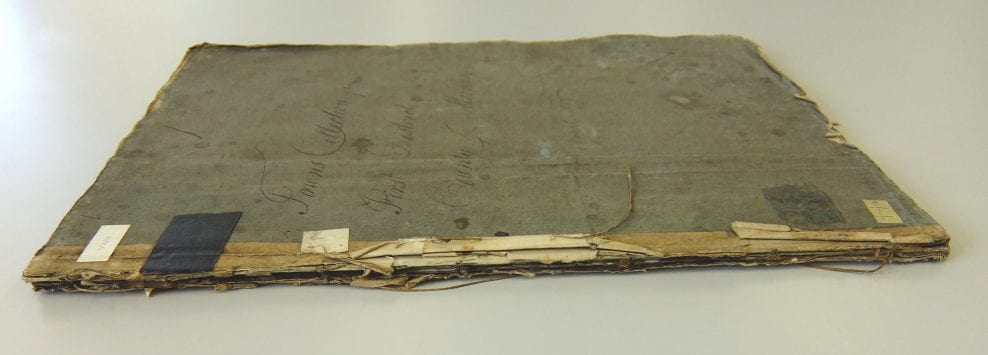Projects
Aberdeen Tax Assessment Registers – Early 19thc
This has been an ongoing project for Aberdeen City Archives Tax Assessment Registers, just completed 2015 – 2019
Description
The volumes are half bound, sewn on hemp (old English haenep) cords. Some of the sewing is staggered, others sewn “all along”. The sections vary from single folios, to three or four folios per section. The paper is handmade with chain lines and watermarks on a paper mould frame; the media is written in iron gall ink used for writing.
The corners of the boards were originally reinforced with parchment, covered in a blue grey paper or blue grey marbling design. The spines are a mixture of two coverings; either brown paper or parchment has been used.
Condition
Within the collection the condition is very similar as the bindings are identical, except from some unique characteristic traits between bindings.
The boards are tired, worn around the edges and spine, the board maybe delaminating slightly and the adhesive sewing has broken down from previous wear & tear and conditions stored in. There are some minor tears through the volume; the boards are loose and the spine maybe missing or in poor condition.
Treatment
All the volumes are collated before disbinding.
The cover and pages are carefully cleaned using an aerated latex sponge and fine goats hair brush. If required, further cleaning was carried out using a grated eraser.
Black insulation tape used to attach the boards, was removed from by heating the tape, this softened the adhesive and a crepe eraser was used to remove any remaining adhesive residue.
Any tears were repaired using a 5gsm Tengucho tissue with a 3% methyl cellulose / 12% wheat starch paste. The repairs are trapped between bondina (an interleave polyester material), blotting paper, board and weight to aid flat even drying.
The sections have been re-sewn using hemp cord, sewn on a sewing frame, and later lined with Atsukuchi 57gsm and Canson Mi Tientes 431 160gsm using paste. The boards have been consolidated using paste, and a western paper Canson Mi Tientes 431 160gsm, has been inserted or attached around the edges of the boards.
The cords were attached to the board using paste and allowed to dry under pressure.
The spine was covered with Canson Mi Tientes 431 160gsm which overlapped onto the covers using 3% methyl cellulose / 12% wheat starch paste if brown paper was used as the covering material.
If the parchment spine bindings are still present, the old parchment has been lifted, the brown Canson Mi Tientes 431 inserted and the original parchment has been adhered onto the brown paper spine lining.


